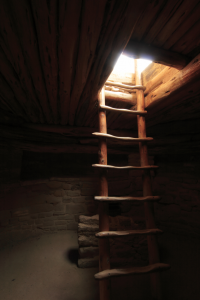Go Deep, Get Dog: Contemplative Spiritual Practice
 A number of years ago when I was working as a therapeutic wilderness guide, a friend of mine, Corey Alexander, told my group and me this story. He said he had been at a Lakota sacred ceremony and afterwards they traditionally have a meal. In the Lakota tradition, dogs are considered sacred food. So, as Corey was getting ready to ladle some of the stew into his bowl, the medicine man told him, “Go deep, get dog.” In other words, the good dog meat was at the bottom of the pot.
A number of years ago when I was working as a therapeutic wilderness guide, a friend of mine, Corey Alexander, told my group and me this story. He said he had been at a Lakota sacred ceremony and afterwards they traditionally have a meal. In the Lakota tradition, dogs are considered sacred food. So, as Corey was getting ready to ladle some of the stew into his bowl, the medicine man told him, “Go deep, get dog.” In other words, the good dog meat was at the bottom of the pot.
After this, “Go deep, get dog” became our rallying cry. We found this very funny but also very profound. It meant to us, Let’s get to the heart of the matter, beyond the surfaces, and find the good meat: dog/God.
As we meditate, becoming ever more aware of and sensing into the interior dimension of our beings, there is an absolutely game-changing growth that happens. Most of us live our lives—in our culture especially—driven by the interiors of our thoughts, what’s going on around us, and driven by our emotions. Sometimes, we’re even cut off from our emotions, or sometimes we’re led by our emotions, but in any event, there is no real depth. Why is this? Because somewhere down the road, we lost our connection with a viable contemplative tradition. The contemplative tradition became pretty corrupt in medieval Catholicism, when it became more about political power and influence. This gave rise to the Protestant Reformation, which rejected contemplative practice altogether in most cases, except for some minor exceptions such as the Quakers, who are an example of a Protestant stream that really latched on to their interior practice and deepened it; as a result, it brought many good things into the world.
Why is interiority so important? As Ken Wilber describes it, when we deepen spiritually, or when we begin to wake up to our own interior depth, it is as if we go from living in a square to living in a cube. A square has four sides but is one-dimensional, and all of a sudden, it can turn into a cube, which is, of course, multi-dimensional, and this changes the whole story.
 As we begin to wake up, we begin to see the depth not just within ourselves—not just in a narcissistic “Woohoo! Aren’t I deep?” kind of way, but in everyone and everything. People who have been unconscious about their own depth, their own true nature, their own divinity, if you will, begin to see it in all things. It’s the old Zen kōan, “Does a dog have Buddha nature?” First of all, I would have to say my dog certainly does, but actually the dog does have Buddha nature, and so does the cat (believe it or not); and so does everything else: the piano, the car, the tree, the bird, and everything else, because everything is nothing but a manifestation of divine presence, intelligence, or emptiness, moment to moment. “Form is emptiness, emptiness is form,” as it says in the Heart Sutra.
As we begin to wake up, we begin to see the depth not just within ourselves—not just in a narcissistic “Woohoo! Aren’t I deep?” kind of way, but in everyone and everything. People who have been unconscious about their own depth, their own true nature, their own divinity, if you will, begin to see it in all things. It’s the old Zen kōan, “Does a dog have Buddha nature?” First of all, I would have to say my dog certainly does, but actually the dog does have Buddha nature, and so does the cat (believe it or not); and so does everything else: the piano, the car, the tree, the bird, and everything else, because everything is nothing but a manifestation of divine presence, intelligence, or emptiness, moment to moment. “Form is emptiness, emptiness is form,” as it says in the Heart Sutra.
This is a powerful idea of inner depth, and when you add it to a dedicated practice, the practice will facilitate the idea. Oftentimes, especially in the masculine and academic-oriented world that has dominated our culture for such a long time, there was the notion that good ideas and a kind of “Got it!” realization was enough. It isn’t. We need to have this idea of interiority and inner depth that goes down to the deepest level and connects us with the essence of who we really are and connects us, at the same time, with the essence of all things, all universes, and all dimensions—which is none other than who we really are. This is not just some big, spacey kind of idea but a very intimate, deeply felt realization and knowing.
I trace this back to India, to the ancient Vedic bards and masters who wrote the very early poems and ancient spiritual hymns and came up with the idea that “atman is Brahman.” What the heck does that mean, you might ask? Well, atman is the equivalent of the individual soul, the individual self, the deepest part of the self. (By the way, atmen means “to breathe” in German, which I think is kind of cool—soul, breath, spirit all in one.) Atman is Brahman, and Brahman is nothing other than ultimate reality, ultimate awareness, ultimate consciousness, creator of all things. So, when you get down to the deepest part of yourself, you find nothing other than the absolute. That is just amazing; it shifts everything.
When you plumb to this depth—and I’m not talking about a once-in-a-while blast of enlightenment, transmitted by a teacher, dumb luck, or a psychedelic drug—of a stabilized awareness that is brought on and sustained ever more deeply by practice, showing up at the well day after day, week after week, month after month, year after year, this realization begins to get into the very pores of our beings and it flows out into the world and connects with all the other points of awareness and consciousness.
So I invite us all, on a daily basis, to “Go deep, get dog.”
___________________________________________________________________________
Adapted from iAwake Technologies’ free, weekly teleconference call on December 5, 2012.
Join our weekly calls!
To receive information on how to join the weekly iAwake coaching calls that John leads, sign up for the free meditation download and you’ll be put on the email list. You can also access the phone-in information on our Teleseminar page.
___________________________________________________________________________
Leave a Comment
You must be logged in to post a comment.

Leave your comments below